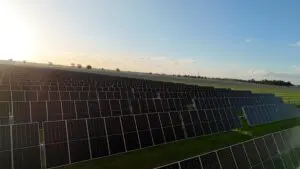It’s only intended as a tongue-in-cheek depiction, but a new map of Eneropa sums up very well why campaigners for community energy are skeptical of designs to create an EU-wide renewable energy system.
As a recent report in the Guardian explains, an architectural office was commissioned to draw up a map of Europe for the European Climate Foundation. The ECF has long been involved in gigantic designs for decarbonization, such as the (failed) Emissions Trading Scheme. Perhaps I have missed something, but I have not seen much work from them on the benefits of community energy. Suffice it to say that communities will be able to tap synergies and couple sectors (such as using waste heat and/or excess renewable electricity for heat supply). They will also handle urban planning to promote efficiency projects (building renovations) along with building bike paths and making urban environments walkable so that we don’t need cars at all.

The vision of an Energy Union is different. Wind turbines would mainly be built in Scotland and along coastlines, for instance, with photovoltaics primarily going up in Spain and Italy. Never mind that the French are not going to fill up their landscapes with power lines so that the Germans can get electricity one cent cheaper – that is simply reality and does not fit economic models.
In a way, the new map is even worse. First, it makes no enemies – the Isle de France becomes “Urania”; the French obviously get to keep their nuclear. It should be pointed out, however, that the region around Paris produces no uranium at all, nor does the rest of France – and French nuclear reactors are by no means located primarily close to Paris.
Eastern Europeans also get to keep their coal plants, apparently. The region is now called the CCSR, meaning Carbon Capture & Storage Republic. Someone should explain to these folks that there is nowhere near enough storage capacity anywhere in the region to match the amount of CO2 that would be need to be captured from all of the coal in the region.
Germany, a country with only marginal geothermal potential, is now practically entirely something called Geothermalia or Enhanced Geothermalia (the former probably being near-surface geothermal for low-temperature heat, whereas the latter could be Hot Dry Rock).
The map is not obviously not intended to be taken completely seriously, but rather to start a discussion. So here are a few points:
- Trying to please everyone will not work. You are going to have to decide, for instance, whether you want nuclear or wind & solar because baseload is anathema to spiky renewables.
- You are going to need a mix everywhere. Placing biomass in one part of Europe is bonkers. First, biomass needs to focus on waste recovery, so it will be local. Second, the further you transport biomass, the worse its carbon footprint becomes. This, cogeneration with biomass needs to be local.
- CCS does not exist as advertised. There is no CCS plant commercially in operation at the moment that does what its proponents claim: leave carbon in the ground. Rather, the commercially successful projects reinject CO2 into the ground to extract more hydrocarbons. Other projects are either subsidized or commercial failures.
- Aside from the Magritte Group, which has always opposed renewables, few entities are excited about the EU’s call for an Energy Union, which is likely to cement energy supply in the hands of corporations rather than enable citizen participation in the sector. This is not the Europe we want.
In other words, every single community will need to look like this map. Each town and hamlet will need to have its own wind, solar, and biomass, and geothermal, hydropower, etc. will be used where applicable.
Craig Morris (@PPchef) is the lead author of German Energy Transition. He directsPetite Planète and writes every workday for Renewables International.
Source: Renewables International. Reproduced with permission.










